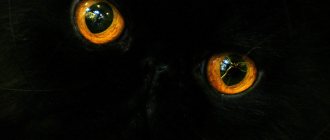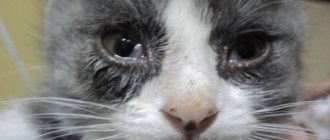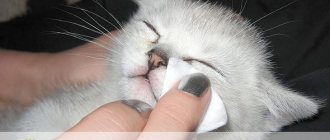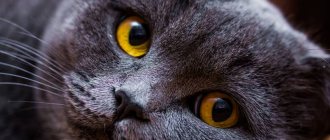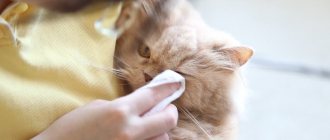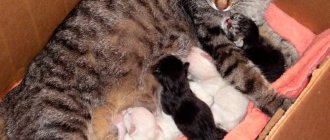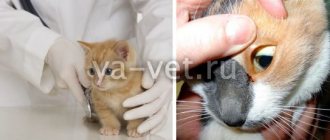Features of heterochromia
Cat fans have different views on this phenomenon. Some people deliberately look for such a pet and consider it a symbol of good luck and prosperity. They are rightfully proud of their unique cat, groom and cherish it, providing ideal conditions so that the pet remains a reliable talisman for as long as possible.
There are reasons for this attitude towards animals with different eyes. Many nations have a belief that the presence of such a cat in the house guarantees protection and helps the owner achieve any goal. Followers of Islam know that the Prophet Muhammad loved his odd-eyed pet Muizza very much. There is also modern evidence in favor of cats with heterochromia. As soon as Bill Clinton had such an animal in his house, he soon managed to win the election and become president.
There are also people among cat lovers who consider odd-eyed pets to be representatives of evil spirits. During the Inquisition, women with heterochromia were called witches and burned at the stake. Many eastern fortune tellers and sorcerers get a cat with different eyes in order to enlist the help of otherworldly forces.
And yet there is no reason to consider a pet with different eyes a bad sign. It is better to get acquainted with the scientific explanations of heterochromia and treat this phenomenon adequately.
Strange eyes and deafness
Deafness in white cats appears to be associated with the white spot gene and the dominant white gene. It is more common in cats with blue eyes or heterochromia. As experts explain, this is due to the fact that the white gene can sometimes cause degradation of the cochlea without disrupting the migration of melanocytes into one or both eyes. The cochlea is the part of the inner ear involved in hearing. This results in permanent deafness in one or both ears.
Multi-colored eyes can be found in completely different breeds. Heterochromia is a normal deviation because such cats are no different from the rest. If your cat with multi-colored eyes is deaf, with proper maintenance and care she will give you the same love and devotion as ordinary cats.
Types of heterochromia
Experts distinguish several types of these anomalies. The criterion by which they are classified is the distribution of shades on the iris. Heterochromia can be:
- full,
- annular,
- sectoral.
In its full form, the anomaly appears as a uniformly colored iris. For the most part, one eye has a rich blue color, the other can be yellow, orange, green, copper, etc.
With ring heterochromia, both irises have the same shade. But on one of them there is a ring-shaped area, painted in a different color. A sectoral anomaly characterizes the presence of an area with a color that does not coincide with the general shade. This phenomenon can occur in one eye or both.
In most cases, a kitten is born with impaired pigmentation of the iris. Sometimes the anomaly is acquired; a change in the color of one eye is caused by certain external reasons. There are cat breeds in which heterochromia is a genetic trait.
Interesting facts about the breed
Some interesting facts to better understand these magnificent animals:
- most Angoras are not afraid of water; on the contrary, they love to swim;
- The appearance of angora dogs in Russia occurred at the end of the 18th century; several animals were presented to Empress Catherine II, at which time fame began to spread about the extraordinary fur of these animals. They were carded, and gloves and stockings were knitted from the wool.
- Despite their dislike of being held, Angora cats are dependent on human communication and have a hard time with separation. No matter what color the Angora cat is, it is always the standard of elegance and grace, an excellent companion and home decoration.
Reasons for the anomaly
A congenital anomaly is not a disease; the body of an odd-eyed cat functions in the same way as that of ordinary pets. There are no changes in visual acuity. The only disorder that in some cases may occur in animals with different eye colors is poor hearing or complete deafness. Therefore, breeders of purebred cats discard such kittens and do not use them for breeding.
Heterochromia can occur in animals of any color. But most often, an abundance or deficiency of pigments occurs in pets with white, light fur, and tricolor cats. Typically, pronounced differences in eye color appear by three months of age.
Acquired heterochromia is a consequence of the use of certain medications or indicates the presence of a disease. For example, in the treatment of glaucoma, eye drops are used, the components of which activate the production of melanin. As a result, the iris takes on a darker shade. Lightening is often a sign of diseases:
- leukemia,
- melanoma,
- uevita,
- diabetes,
- neuroblastoma, etc.
Acquired heterochromia should be the reason for a visit to the veterinarian and diagnostic testing.
Is this a disease?
Congenital heterochromacy is not a disease and does not affect a cat’s visual acuity in any way. But it can affect your hearing.
But if we are talking about purebred animals, then such an individual is removed from the breeding program in order to minimize the possibility of the birth of deaf kittens and stop the spread of the defect in this species.
We invite you to familiarize yourself with the Cat family - species and representatives of predatory animals
There are two types of acquired heterochromacy:
- Abnormal darkening of the iris. It is caused by iron deposition (siderosis) and can also be triggered by the use of certain eye drops by stimulating melanin growth. These are, for example, drugs to reduce intraocular pressure, which are used to combat glaucoma.
- Abnormal lightening occurs due to atrophy of the iris due to inflammation, due to neuroblastoma, melanoma, uevitis, leukemia and some other pathologies.
Different eye colors as a sign of breed
Different eye colors are not always an anomaly. There are cat breeds in which this trait is inherited and is considered one of the characteristic traits. These include:
- turkish angora,
- kao mani,
- Turkish van.
Representatives of these breeds have a snow-white color or white is the main color in them.
Various disasters and wars have put the Turkish Angora breed under threat of complete extinction. The disaster was prevented by the attention of the Turkish government to these animals. Now cats of this breed are under state protection and are a national treasure.
The most expensive and rare pet is the Kao Mani cat. Since time immemorial, these animals have lived in Thailand. Short-haired snow-white cats, like representatives of the Turkish Angora, are protected by the state and are considered the national breed of Thailand.
The Turkish Van breed is the result of selection. The ancestors of modern representatives were wild cats living on the shores of Lake Van. The main prey of these predators is fish. Each hair of the thick, semi-long coat is well lubricated with subcutaneous fat. The cat does not get wet during water hunting.
It was the Turkish Vans that made odd-eyed pets popular. In the Turkish city of Van, a monument was erected to an odd-eyed cat. One eye represents the sun, has a golden tint, the second symbolizes the sky, its color is blue.
Heterochromia in animals of these breeds manifests itself similarly. One eye has a deep blue tint. The color of another iris can be amber, honey, green, orange.
Main breeds of odd-eyed cats
There are breeds for which different-colored eyes are more likely. This does not mean that heterochromia does not occur in other cats, but it is much less common in them.
Be sure to read:
How cats treat people: 4 ways, basic rules, what breeds, what diseases they get rid of
For pets with different colored irises, prolonged exposure to the sun is harmful due to the increased likelihood of cancer: in the summer, carefully monitor where they are.
When getting a cat of this type in areas with summer heat, the owner needs to lock it indoors during the daytime, since all cats love to lie in sunny places.
Turkish van
Turkish Van
A common breed of cat that has colored eyes. Half of its representatives have a special appearance. Cats with an original appearance are valued in Turkey, where they were awarded a monument.
Many animals have a special Van color, in which all the fur on the body is white, and there are dark markings on the face and head. Most often these spots are cream-colored, less often red or blue. Rarely found are Turkish Vans with multi-colored eyes, tortoiseshell in color with white spots. All color options are fixed by the standard.
The coat of the breed is soft and silky. Semi-long, it requires regular combing. The fluffy tail looks wide. The size of the animal is large.
The pet's character is sociable, so it needs constant attention from its owner. The cat follows the person, demands affection, and willingly participates in children's games.
The animal loves to sit on your lap and does an excellent job as a companion . Bouncing vans can easily be climbed onto refrigerators, cabinets, and mezzanines. With proper training, pets willingly bathe. The natural intelligence of Turkish Vans allows them to be trained by teaching them basic commands from a dog course.
Turkish Angora
Small cats, distinguished by their pleasant nature and soft-to-touch fur, often have multi-colored irises. Pets may have different colors, but they have the same probability of heterochromia.
Turkish Angora
Most bicolor cats are deaf. The stable immunity of animals simplifies their maintenance and significantly reduces the risk of infectious diseases, even if the pets go out for walks.
Be sure to read:
Cats in ancient Egypt: their meaning, features of appearance and character, education and training
Representatives of the breed are playful and highly demanding of attention. Because of this, when getting such a pet, you cannot leave it alone for a long time. The solution for owners who spend the day at work is to buy two kittens (preferably from the same litter), which will fully satisfy the need for communication in each other’s company.
Khao-mani
Khao Mani
A short-haired white breed native to Thailand. She is rare and the kittens are expensive. Finding them is not easy. The eyes of representatives of the breed often have an iris of two colors and look especially unusual.
The character of the animal is capricious. You cannot keep a cat and leave it alone for a long time. Clean, they quickly get used to the tray. Low activity allows you to place your pet in a small apartment.
Heterochromia in other breeds
As an anomaly, different eye colors can appear in animals of different breeds. This phenomenon is often observed in cats:
- marble and tortoiseshell color,
- Persian,
- exotics,
- sphinxes,
- oriental,
- British, British
- Scottish,
- rex.
You can see odd-eyed cats among the yard tricolors. In most cases, different shades of the iris are formed in animals whose color white occupies more than half of the body area.
The manifestation of this feature is unpredictable and can occur in cats of any breed. There is only one condition for the formation of different colors of the iris. The animal must have a white gene that is inherited.
cat eyes
A cat's eyes are significantly larger compared to the size of its head. This is actually a key feature of all nocturnal animals, as is the vertical structure of the pupils. The actual eyeballs are placed in bony cavities called orbits. The white part of the eye is called the sclera, and it is covered by a thin membrane called the conjunctiva. The conjunctiva closes the eyelids. Before the eyes is a transparent dome cornea. The cornea protects the eyes and allows light to pass through. The round colored area of the eye is the iris.
Cats are quite poor at discerning small details, but the theory that cats see the world in black and white is considered incorrect. Interestingly, cats have a third eyelid, which can be seen when the cat is happy or sick.
